Moose to the Rescue
This West Coast boat builder stays busy creating high quality fireboats for a diverse set of demanding, multi-missioned first responders. For Moose customer satisfaction is the name of the game. This year, they’ve got that box checked.Vallejo,CA-based Moose Boats builds aluminum catamaran and monohull vessels designed to meet a variety of mission-specific applications for military, law enforcement, emergency response, firefighting and security patrol purposes. It’s been a busy year for Moose, who also recently laid the keel for a 75’ catamaran crew boat for Westar Marine Services in San Francisco. But, it is fireboats that this builder is known for. And, at present, it would not be an exaggeration to say that fireboats are ‘hot’ for Moose Boats.
New Moose Boat For SFFD
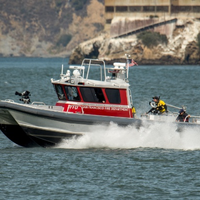
Moose Boats delivered a M2-38 Catamaran CBRN, Dive and Fire Rescue vessel to San Francisco Fire Department.A pair of Cummins QSB6.7 425hp turbo diesel propulsion engines with Hamilton HJ292 water-jets will power the M2-38 aluminum catamaran. Serving primarily as a dive and rescue boat, the M2 is outfitted with an integrated dive/recovery platform and a bow ladder for beach rescues.Due to the Moose Boat’s Homeland Security role, it is also equipped with a Hale fire pump flowing in excess of 1…
San Francisco Orders a New Fire Boat
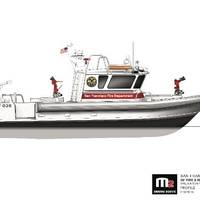
California boat builder Moose Boats said it was awarded a contract from the San Francisco Fire Department for the construction of a M2-38 Catamaran CBRN, Dive and Fire Rescue vessel to enter service in the third quarter of 2018. The aluminum catamaran, which is 75 percent funded by FEMA’s FY2015 Port Security Grant Program, will be powered by twin Cummins QSB6.7 425hp turbo diesel propulsion engines with Hamilton HJ292 waterjets. Serving primarily as a dive and rescue boat, the vessel will be outfitted with an integrated dive/recovery platform and a bow ladder for beach rescues.
Port of Antwerp Gets Nuke Detectors
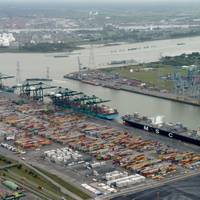
Arktis Radiation Detectors was selected to supply radiation portal monitors and mobile detection systems to the Belgian Government, for use at the Port of Antwerp. Under the contract, which has been let by the Belgium Ministry of Finance, Arktis and partner Bavak - Arktis’ exclusive distributor for the Benelux Region - will supply the port with radiation detection equipment for the largest capacity container terminal in Europe, located at the Left Bank in the Port of Antwerp.
Moose Boats is Keeping Busy
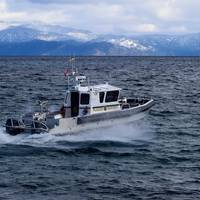
U.S. Moose Boats, a boat designer and manufacturer in the San Francisco Bay Area, announced two recent vessel deliveries: a M2-35 Catamaran Patrol Boat to the Placer County Sheriff’s Office in Carnelian Bay, Calif., and a M2-38’ 3,000GPM Fire Rescue Catamaran to the Bellingham Fire Department in Bellingham, Wash. The builder has received an additional order to build a M2-38 Catamaran CBRNE Emergency Response and Recovery Vessel for the New Bedford Fire Department in Massachusetts.
Moose Boats Deliver Patrol Boat to NYPD
Boat designer and manufacturer in the San Francisco Bay Area, Moose Boats, said it has delivered a M2-35 Catamaran Patrol Boat to New York City Police Department’s Harbor Unit. The 35 foot all-aluminum catamaran vessel is a sister ship to NYPD’s three existing Moose Boats M2- 35 catamarans, the first of which has been in service since December 2009. The vessel will be responsible for patrol, search and rescue, recovery and dive operations in New York Harbor and the East and Hudson Rivers. Propulsion is achieved by twin Yamaha 350hp four-stroke outboards, and a Northern Lights generator powers integrated heated decks and windows as well as reverse cycle air conditioning.
Dying a Slow Death
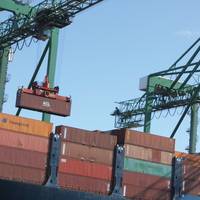
The United States Congress cannot legislate technology ... but it keeps trying. A case in point is the requirement for scanning in a foreign port of all containerized cargo bound for the United States (the so-called 100% scanning requirement). It was supposed to come into effect on 1 July 2012. That date has been pushed back to at least 1 July 2014, if ever. The major reason for the delay is that no equipment capable of scanning maritime shipping containers in a practicable manner has been invented. The law, though, remains in place.
GAO –DHS Programs Lack Oversight
The Government Accountability Office (GAO) issued a report stating that some major Department of Homeland Security (DHS) programs lack appropriate oversight. For example, the Secure Freight Initiative, designed to test the feasibility of scanning 100% of US-bound cargo containers with nonintrusive equipment and radiation detection equipment at foreign seaports, has an estimated life-cycle cost of $1.7 billion. The program faces a number of challenges, including measuring performance outcomes, logistical feasibility of some aspects of the investments, and technological issues. GAO-09-29 (11/20/08). (Source: Holland & Knight)
Rotterdam Trials Radiation Detection Equipment
February 10, tests with four radiation detection gates started at the Delta terminals at Maasvlakte. The four can handle check some one million containers per year. The tests are technical as well as aimed at minimizing the impact on logistic operations and will last into April. If successful a plan will be drawn up to install a few dozen of gates at the vital locations in the port area.
AAPA Tells Congress Funding Falls Short
American Association of Port Authorities' (AAPA) Chairman of the Board Dick Steinke, executive director of the Port of Long Beach, told Congress today that at least 52 U.S. public port agencies say they intend to apply for Department of Transportation Port Security Grants totaling $222.8 million. This far exceeds the $93.3 million appropriated by Congress for this program. Steinke testified on behalf of AAPA during a hearing of the Subcommittee on Coast Guard and Marine Transportation, House Transportation and Infrastructure Committee. As state and local government agencies, Steinke said in written testimony, public port authorities warrant Federal help and assistance, to avoid new requirements becoming unfunded Federal mandates. Grants, he explained, are the best way to do this.
Ports Applaud Increased Funding For Security
Increased funding for port security in H.R. 3983, the "Maritime Transportation Antiterrorism Act of 2002," was passed the House on June 4. The FY '02 supplemental appropriations bills, which the House has passed and the Senate may vote on this week, also include additional port security funds. "Greater resources are critical for continued improvements in security at our nation's ports," said Kurt J. Nagle, president of the American Association of Port Authorities (AAPA). "We applaud Congress for recognizing this need, and for its investment in helping to secure port facilities from terrorist attacks. H.R. 3983 authorizes $225 million for Federal grants to help ports enhance seaport security, and allows local flexibility to address terrorism at America's ports.
DOT Grants Will Help Enhance Security Measures
Seaport security grants totaling $92.3 million announced by Department of Transportation (DOT) Secretary Norman Mineta on June 17 will help provide urgently needed funding to the nation's port authorities for security enhancements. Ninety-five percent of the nation's overseas trade by volume moves through ports. Since September 11, 2001, ports have invested millions of dollars to improve security at marine terminals. The DOT funding will help a number of them conduct port vulnerability assessments, and continue to improve security measures such as personnel (a recurring annual cost), gate and entry controls, surveillance systems, lighting, X-ray equipment, fencing and radiation detection equipment.
The 5% Myth
U.S. Customes and Border Protection issues a release to try and dispel what it calls common myths regarding container inspection. 95-percent of the containers that come into the ports are not inspected. · The 95-percent figure is misleading and falsely implies that we do nothing to inspect cargo containers arriving at our seaports. We use intelligence to review information on 100 % of cargo entering our ports, and all cargo that presents a risk to our country is inspected using large x-ray and radiation detection equipment. · Following 9/11, the Administration developed and implemented a smarter strategy to identify, target, and inspect cargo containers before they reach U.S. ports.
DHS Announces West Coast Maritime Radiation Detection Project
The U.S. Department of Homeland Security’s Domestic Nuclear Detection Office (DNDO) announced the West Coast Maritime pilot program that will provide maritime radiation detection capabilities for State and local authorities in Washington’s Puget Sound and California’s San Diego areas. The three-year pilot program involves the development of a radiation detection architecture that reduces the risk of radiological and nuclear threats that could be illegally transported on recreational or small commercial vessels. The pilot will be conducted in close coordination with the U.S. Coast Guard and Customs and Border Protection. DNDO anticipates investing roughly $10 million in the pilot program.
Senate Passes GreenLane Port Security Legislation
The Senate passed the cargo security legislation authored by U.S. Senator Patty Murray (D-WA) that is aimed to improve the security of America 's ports and cargo container system. Murray 's bill passed by a vote of 98-0. Senator Murray has spearheaded the effort to protect America 's ports since the terrorist attacks of September 11th. She spent the past week on the Senate floor managing debate on her bill. The bipartisan bill, which Murray introduced with Senator Susan Collins (R-ME) – raises security standards for all cargo entering the U.S. , creates a GreenLane to track and monitor cargo, creates a system to resume trade after an incident, and funds port security grants.
Rep. LoBiondo Hails Enactment of SAFE Ports Act
U.S. Congressman Frank A. LoBiondo (NJ-02), Chairman of the House Coast Guard and Maritime Transportation Subcommittee hailed the enactment of the SAFE Ports Act and to discuss port security at local Delaware River Ports. Rep. LoBiondo was joined by Joseph Balzano, CEO of the South Jersey Port Corp. as well as Dennis Rochford, President of the Maritime Exchange for the Delaware River and Bay. "I am very pleased to be at the Port of Camden today to talk about this important new port security law.� said Rep. LoBiondo. Require those in charge of security at our nation�s ports (Facility Security Officers) to be American citizens. Require the Coast Guard to conduct unannounced periodic inspections of U.S.





